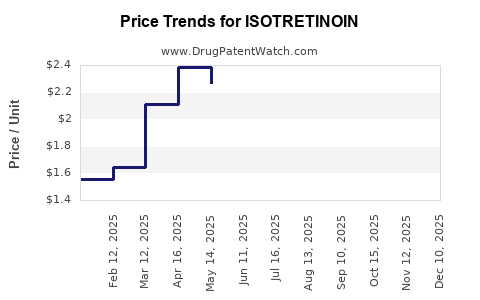Drug Price Trends for ISOTRETINOIN
✉ Email this page to a colleague

Average Pharmacy Cost for ISOTRETINOIN
| Drug Name | NDC | Price/Unit ($) | Unit | Date |
|---|---|---|---|---|
| ISOTRETINOIN 20 MG CAPSULE | 59651-0632-03 | 13.01485 | EACH | 2024-12-04 |
| ISOTRETINOIN 40 MG CAPSULE | 59651-0636-03 | 16.70926 | EACH | 2024-12-04 |
| ISOTRETINOIN 20 MG CAPSULE | 59651-0632-10 | 13.01485 | EACH | 2024-12-04 |
| ISOTRETINOIN 40 MG CAPSULE | 59651-0636-10 | 16.70926 | EACH | 2024-12-04 |
| ISOTRETINOIN 40 MG CAPSULE | 70710-1025-08 | 1.94559 | EACH | 2024-11-20 |
| >Drug Name | >NDC | >Price/Unit ($) | >Unit | >Date |
Best Wholesale Price for ISOTRETINOIN
| Drug Name | Vendor | NDC | Count | Price ($) | Price/Unit ($) | Unit | Dates | Price Type |
|---|---|---|---|---|---|---|---|---|
| MYORISAN 40MG CAP | Golden State Medical Supply, Inc. | 61748-0304-13 | 30 | 78.73 | 2.62433 | EACH | 2023-06-15 - 2028-06-14 | FSS |
| ISOTRETINOIN (EQV-ACCUTANE) 30MG CAP | AvKare, LLC | 69238-1017-03 | 30 | 181.16 | 6.03867 | EACH | 2023-06-15 - 2028-06-14 | FSS |
| MYORISAN 10MG CAP | Golden State Medical Supply, Inc. | 61748-0301-13 | 30 | 65.74 | 2.19133 | EACH | 2023-06-15 - 2028-06-14 | FSS |
| ISOTRETINOIN (EQV-ACCUTANE) 10MG CAP | AvKare, LLC | 69238-1174-03 | 30 | 62.76 | 2.09200 | EACH | 2023-06-15 - 2028-06-14 | FSS |
| MYORISAN 20MG CAP | Golden State Medical Supply, Inc. | 61748-0302-11 | 100 | 704.00 | 7.04000 | EACH | 2023-06-15 - 2028-06-14 | FSS |
| >Drug Name | >Vendor | >NDC | >Count | >Price ($) | >Price/Unit ($) | >Unit | >Dates | >Price Type |


